Growing your own food will increase your self-sufficiency and food security. Unfortunately, not everyone has the time, weather, resources, land, or even the necessary knowledge and skills to achieve a successful outdoor garden. This is especially true for people who live in confined urban areas with little to no outside space, who reside in regions of the country with short growing seasons, who don’t have the ability to maintain outdoor garden, or who may live in communities with homeowner’s associations that don’t allow residents to have an outside vegetable garden.
Faced with these challenges, many people give up on growing their own food — it seems like there are just too many obstacles to overcome. However, there are now viable alternatives to traditional outdoor gardening. Enter the indoor hydroponic garden.
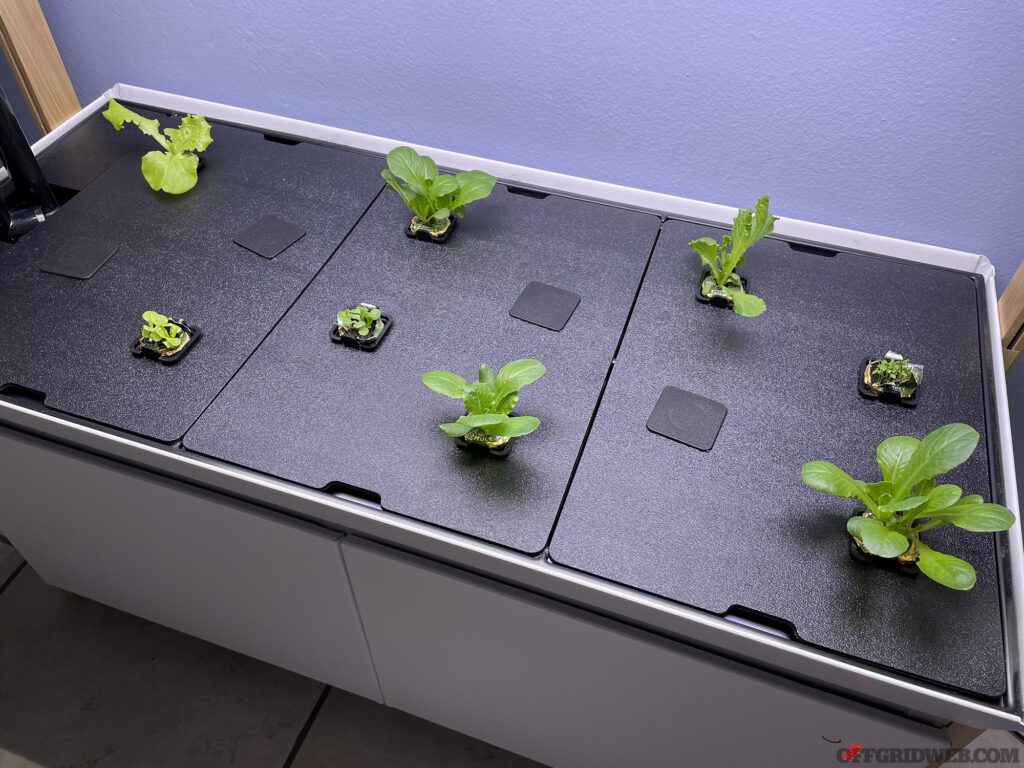
Above: At this stage of development, it’s difficult to imagine, but within 30 days these tiny seedlings will grow into mature plants large enough to harvest and begin feeding your family.
In this article, we’ll look at the Rise Family Garden, and explore some of the many benefits of using an indoor hydroponic garden to efficiently grow your own food, in a safe and secure environment, unaffected by inclement weather, insects, pests, soil conditions, or prying eyes.
Disclaimer: The materials provided are for illustration and/or informational purposes only. Any use of the information contained in this article shall be solely at the reader’s risk.
Sustainable Survival Food
Many people understand the importance of storing at least a three-month supply of emergency food. With the recent supply chain disruptions, food shortages, and skyrocketing prices, many more folks are now starting to realize that relying solely on grocery stores and online retailers may be a very risky strategy. The importance of emergency food stores has never been greater, but storing non-perishable foods may not be enough. Growing some of your own food is an excellent way to supplement your emergency supplies, and to add variety and freshness to any food plan, while also mitigating your risk and increasing your options.
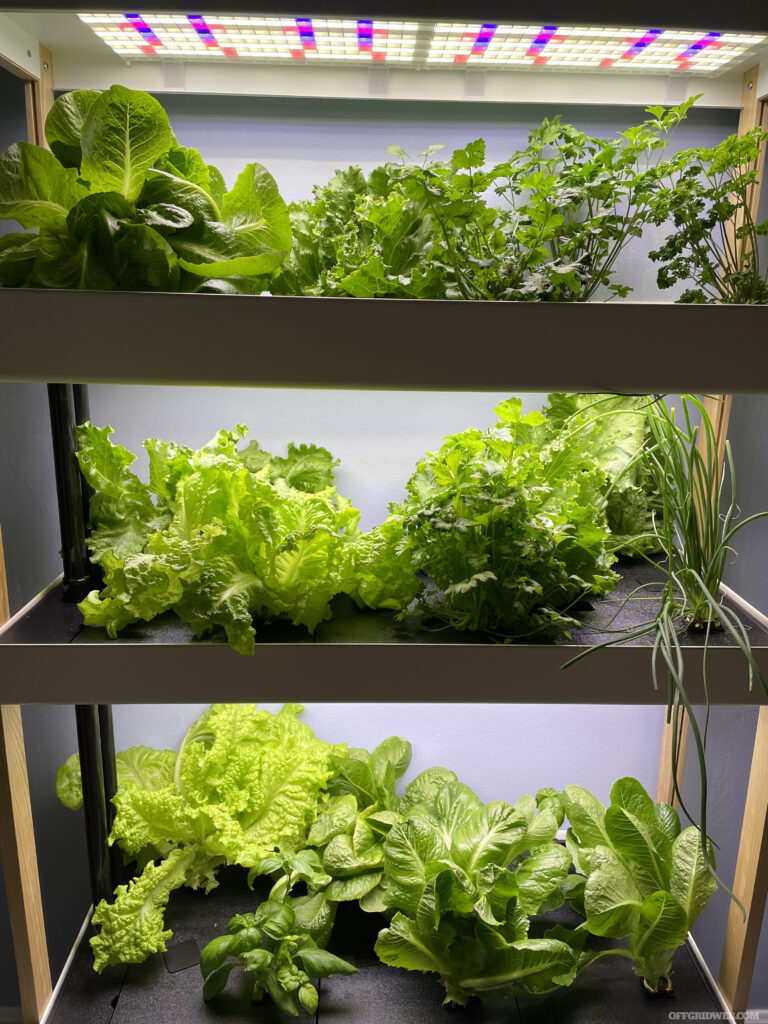
Above: Five weeks into the grow cycle and all the plants are ready to start feeding you and your family. The three-level Family Garden is compact, but has enough capacity to grow dozens of plants, and provide your family with a substantial amount of fresh produce over an extended period of time.
Hydroponics 101
Hydroponics is a technique of growing plants (usually greens, vegetables, and herbs) in a controlled environment. “Hydro” (meaning water) and “ponics” (meaning work) are combined to describe a method of growing plants with water, nutrients and sunlight, or appropriate color spectrum LED lights, but without soil. The LED lights, used by indoor hydroponic gardens, are specially designed to mimic sunlight and maximize growth.
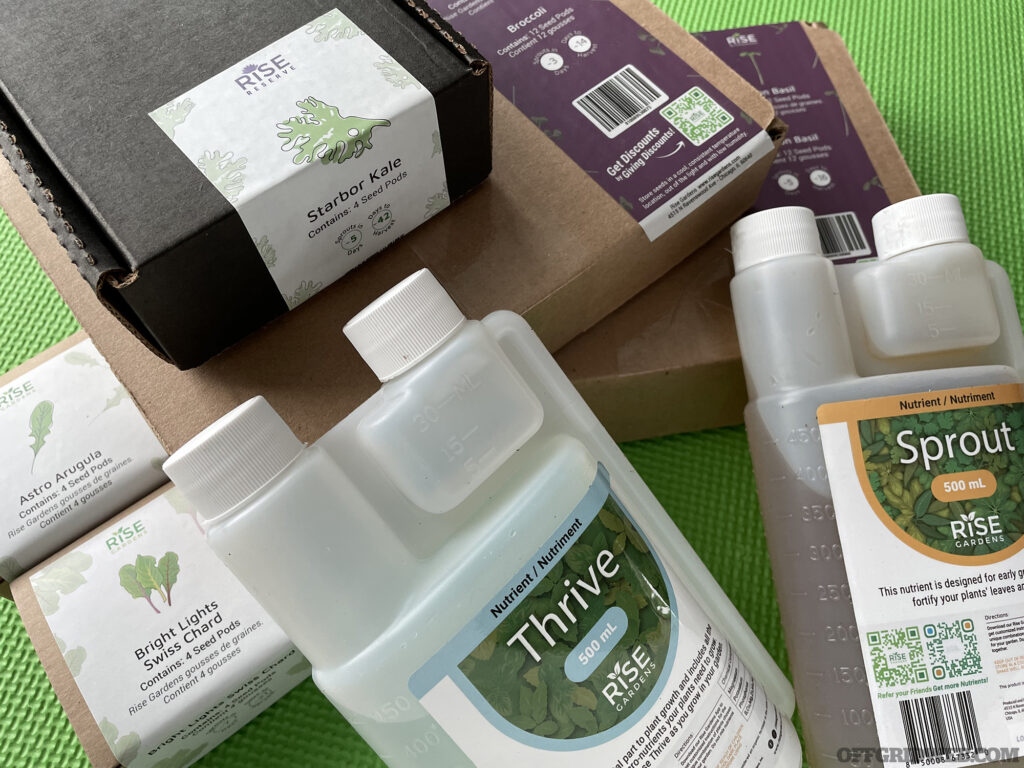
Above: Despite their small size, microgreens pack a concentrated nutritional punch that makes them an excellent choice for any survival garden. Rich in flavor and easy to grow, microgreens contain more nutrition than much larger vegetable greens. Microgreens also provide high levels of vitamins, minerals, and antioxidants. Rise solutions contain all the essential nutrients plants need for healthy growth.
Although this all sounds very high-tech, what we call “hydroponics” today is actually based on some very ancient farming techniques that date back thousands of years; some say as far back as the ancient Egyptians, Romans, and Greeks. It wasn’t until the mid 1800s and early 1900s, however, that the first modern hydroponic systems began to take shape, and scientists developed the concepts that’d eventually become the basis for the systems we use today.
Modern hydroponic systems provide complete control over the growing environment, and with the simplicity of self-watering and self-fertilizing, the results are larger yields and healthier, more nutrient-rich produce. Modern indoor hydroponic systems are also much more efficient than traditional outdoor gardening, since they use much less water and aren’t dependent on favorable weather.
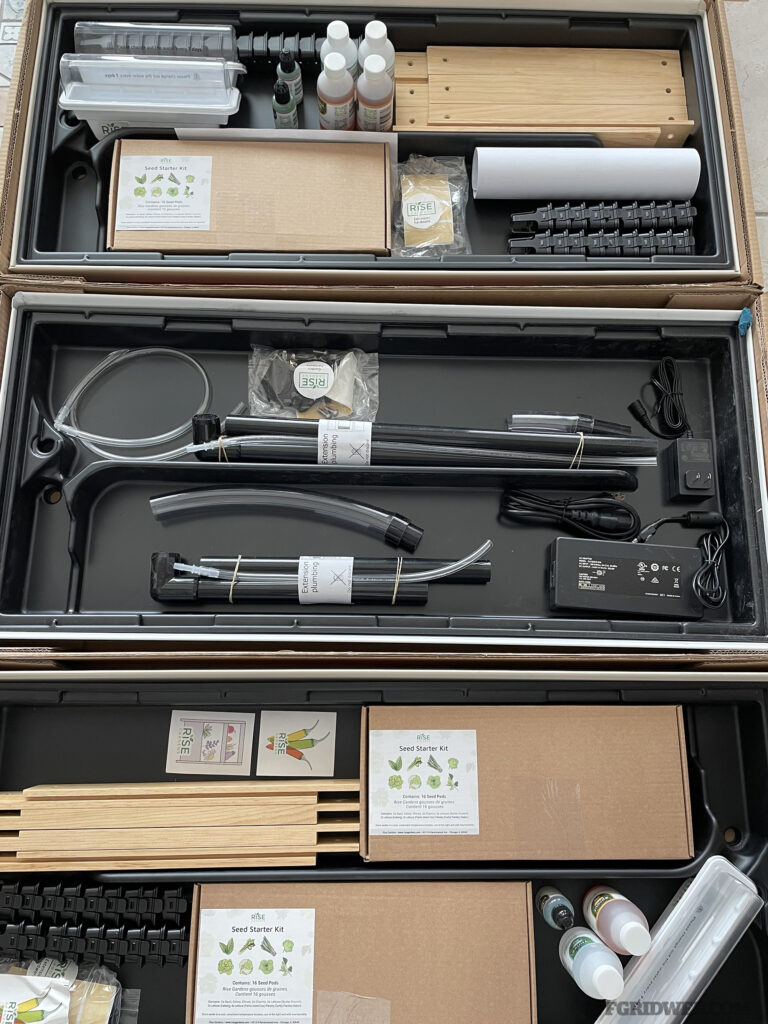
Above: The Rise Family Garden comes with everything you need to get started. All the necessary components are clearly labeled, organized, and ready for assembly. An instruction booklet is included, or you can watch the assembly videos on the Rise website.
Advantages of Hydroponics
- Hydroponic systems are closed and recycle water. This can represent an up to 90 percent more efficient use of water, and is a superior way to deliver a precise amount of micro-nutrients to the plants.
- By controlling temperature, lighting, water, and nutrient flow, hydroponic gardening can increase produce production by 3 to 10 times over the same amount of space in a traditional garden.
- By moving the farm indoors, produce can be grown year-round, and in places where weather conditions may not be favorable.
- Indoor hydroponic systems don’t require chemical weed, pest, or critter control products.
- Hydroponic systems are designed to make the most of the available growing area by using vertical space instead of horizontal space.
- Hydroponic systems can be positioned closer to the end user, shrinking the amount of time from harvest to consumption, and dramatically increasing the nutritional content of hydroponically grown produce.
- Plants grown hydroponically can grow up to 50% faster than similar plants in soil.
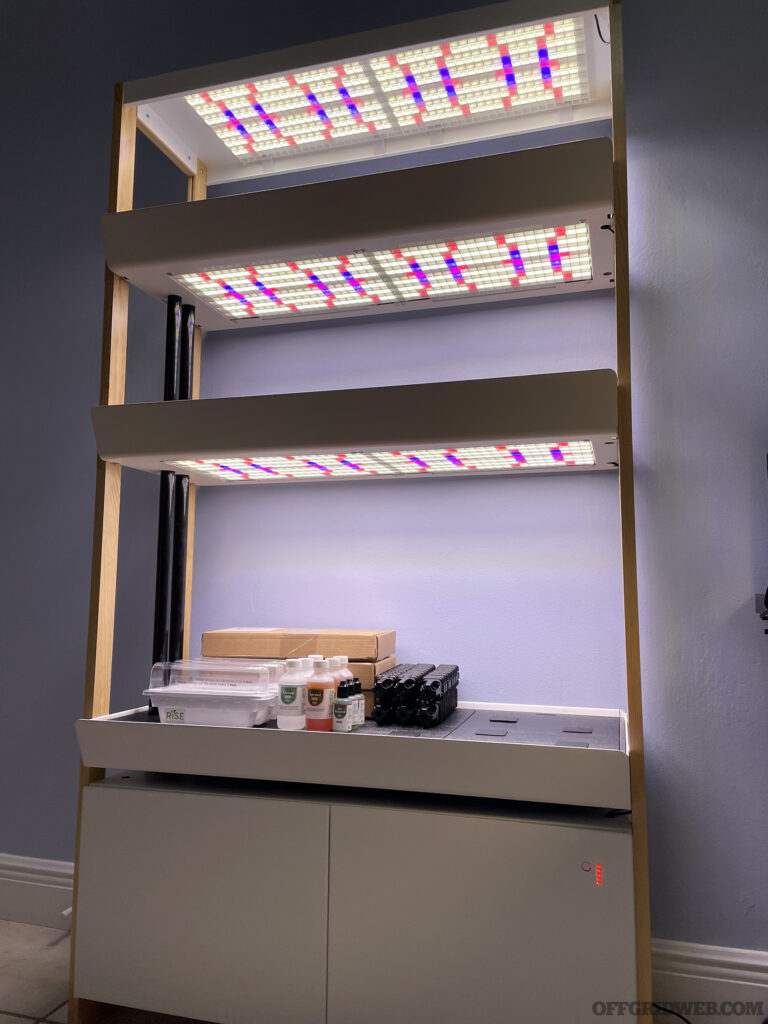
Above: The fully assembled Family Garden has three growing levels (lowest level is the tallest). Each level has its own water supply and grow lights. The Garden comes with a one-year warranty.
Rise Hydroponic Gardens
For this article, we reviewed the Rise Triple Family Garden, a three-level indoor unit with a sleek design that resembles a modern Scandinavian bookcase. Since the garden looks very much like a piece of nice furniture, it’ll fit right in with just about any home décor. The unit measures 36 inches long by 16 inches deep by 66.25 inches high and is fully self-contained.
We chose the Three Level Garden for its increased capacity and technological advancements/features that automate and simplify the growing process. We’ve summarized some of these key features below:
- App-Enabled – The Rise Gardens App monitors the garden’s systems, and tells you when it needs water, nutrients, etc. It also provides reminders, tips, and suggestions. Using what the folks at Rise call SmartCare technology, the App walks you through every step of the process, from seedlings to harvest. You can control and monitor your garden with the App, or you can even sync with Alexa.
- Full Spectrum – LED Lights. The cutting-edge, full-spectrum lighting system is specially designed to mimic sunlight and maximize plant growth. The on-board controller ensures your garden gets the right amount of light, usually 16 hours a day. The system even simulates sunrise and sunset with a gradual dimming/brightening feature.
- Smart Watering – The self-watering system is designed to deliver the precise amount of water, and nutrients, to maximize growth. The App will alert you when the water levels run low or get too high. When it’s time to add nutrients, the App will tell you precisely what nutrients to add, and in what amounts.
- Modular Design – The modular system allows you to expand your garden. You can start with a single level and expand up to three levels. Each level will have its own water supply and LED lighting system.
- Advanced Seed Pods – All plants start life as seeds in pods made from coconut coir and peat moss. The Rise Nursery is designed to create just the right environment for the seedlings to grow until they’re ready to transition to the garden, usually within five to seven days.
The Rise Garden comes with everything you’ll need to start growing right away — just put it together, plug it in, and add water.
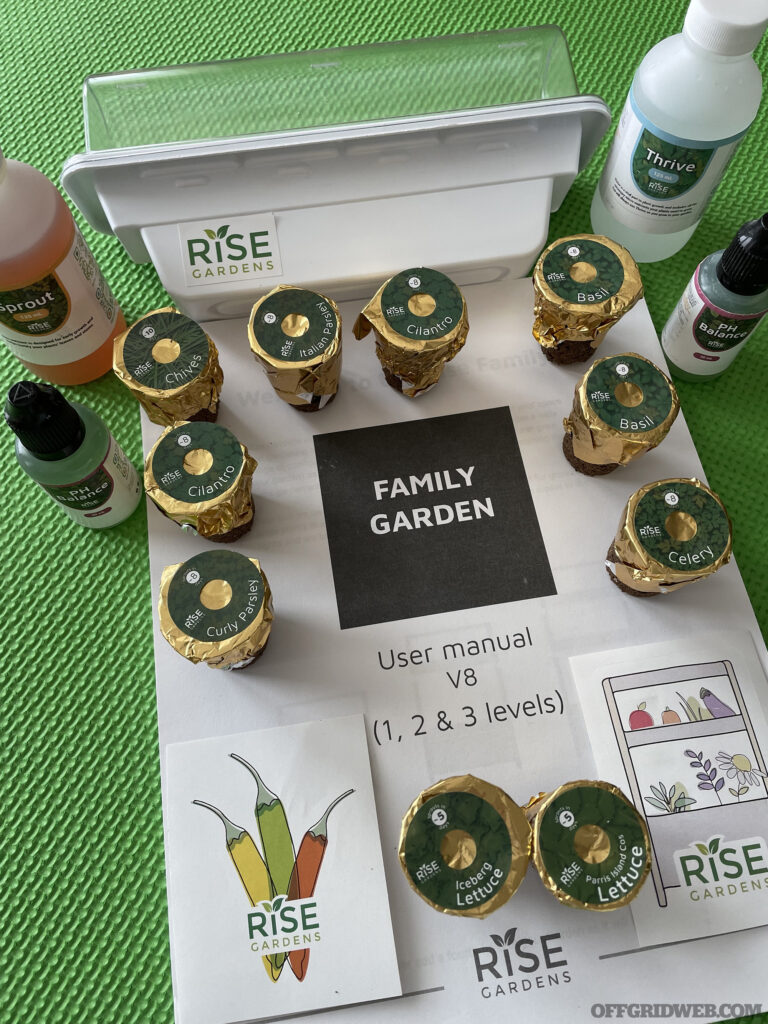
Above: The Rise Garden comes with a selection of seed pods, nutrients, PH balance solution, a nursery, and instructions. The three level gardens come with enough supplies to start growing on all three levels.
Self-Sufficiency and Privacy
For people who want to become more self-sufficient and increase their food security, an indoor hydroponic garden offers many benefits, one of the most significant being privacy. You can grow a substantial amount of fresh food right inside your own home 365 days a year — this is huge. Traditional outdoor gardens aren’t only vulnerable to critters, but in a dire food shortage, they might also get raided by two-legged critters.
The high visibility of an outdoor garden lets the world know your yard is rich in resources and makes your house a target. Growing indoors vastly reduces your visibility and allows you to grow a good amount of food without displaying any of the obvious signs of a traditional garden. During turbulent times, an indoor garden also reduces the amount of time you must spend outdoors tending to a garden. Security and self-defense are a top priority in any survival situation; the less time you spend outdoors, and the less people know about your preparations, the safer you’ll be.
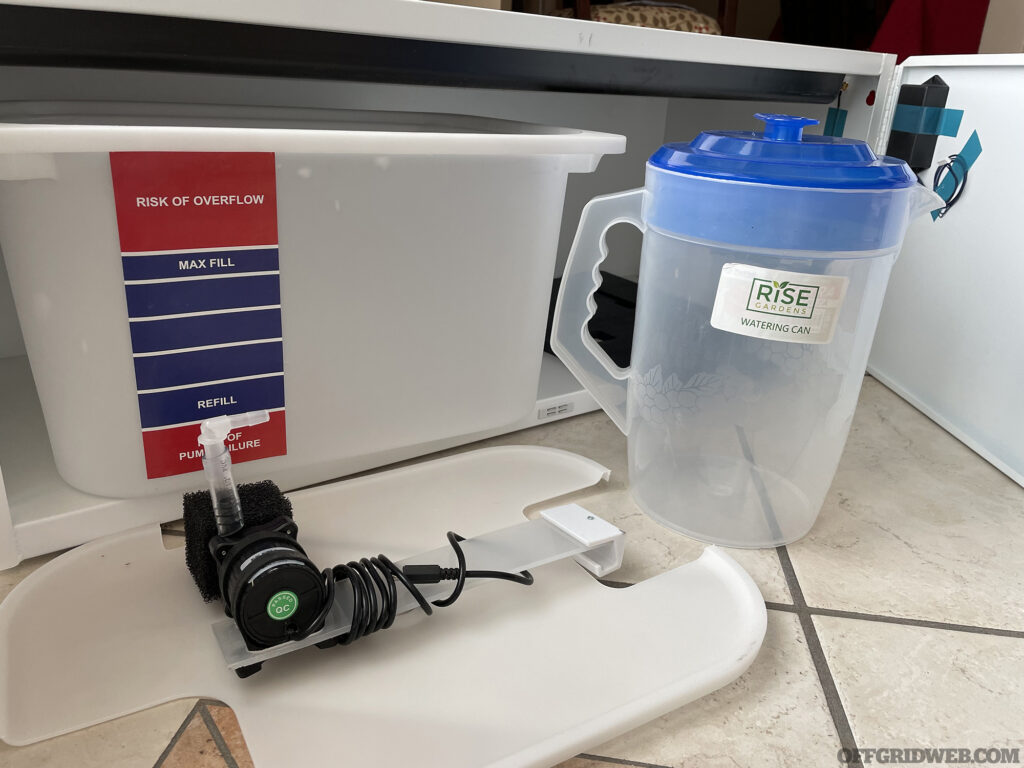
Above: Contained within the lower cabinet is the water tank and pump assembly that continually circulates the nutrient-rich, oxygenated water throughout the various levels of the garden. The watering can allows you to easily add water to maintain the proper levels.
Growing with Less Water
In a traditional outside garden, it’s estimated that as much as 50 percent of the water used for irrigation is lost due to evaporation, wind, or runoff. These estimates may vary according to a variety of factors, but an outdoor garden will always require far more water, and a good deal of that water will be lost. This can be a big problem for your outdoor garden if water is in short supply.
The water requirements for an indoor hydroponic garden will depend on the size of your unit and how many plants you’re growing. But, since the water is constantly circulating and being reused, your hydroponic garden will require far less water than a traditional outdoor garden. For example, a fully planted three-level Family Garden will consume about four gallons of water per week.
This represents a substantial water savings over traditional growing methods that would typically require much more water over the same period of time for a similar amount of produce. Whether you’re facing a water shortage or simply tired of paying increasing irrigation bills, this is a major advantage.
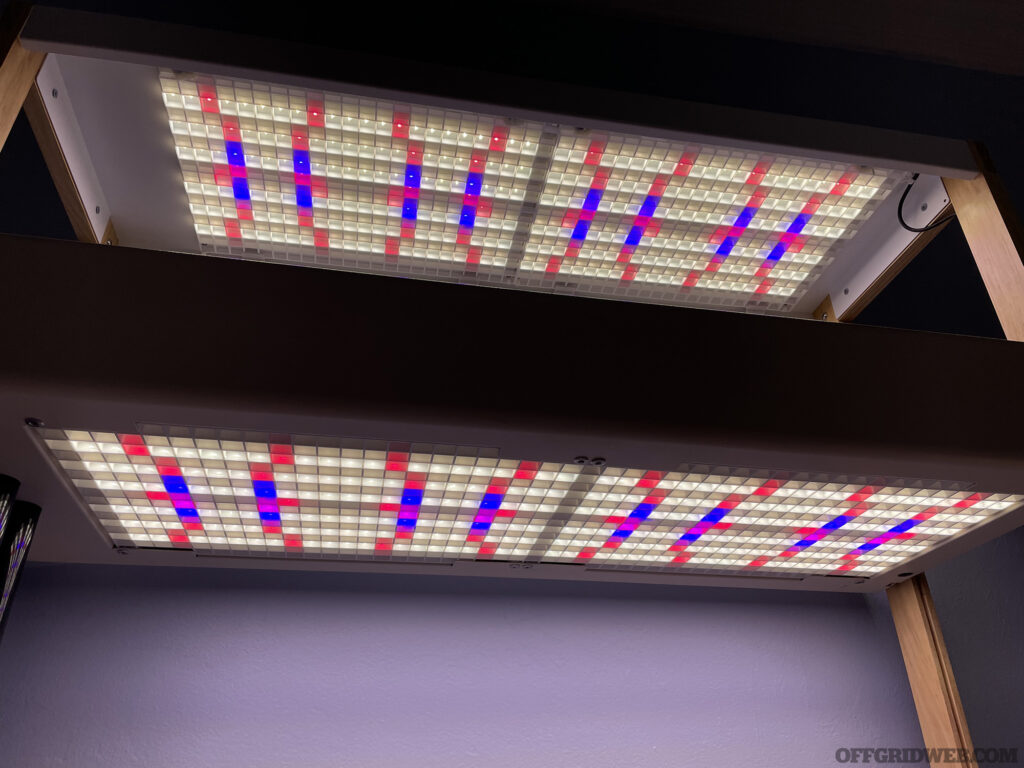
Above: Designed to maximize plant growth, the innovative, full-spectrum lights mimic the natural light of the sun, and even simulate sunrise and sunset.
Fresh, Nutrient-Rich Produce at Home
Homegrown veggies offer far more nutrients than the produce we normally buy at the local supermarket. Deterioration in the nutritional content of veggies starts as soon as these crops are harvested. The further away you are from the source, and the more time the produce spends in transit or storage, the more nutrients are lost. Store-bought produce has usually spent at least one week in transit, storage, and in warehouses before it ever reaches your local market; all these factors contribute to nutrient loss. According to the folks at Rise, the fresh produce you get from your garden is not only more flavorful but contains as much as 70 times more nutrients than produce you buy from your local grocery store.
You can take this one step further — to maximize the nutritional value of your homegrown produce, focus on plants with high nutrient density like microgreens, kale, Swiss chard, and beets. Not only are these plants very high in essential nutrients, but they only have to travel the distance from your garden to your table. Microgreens also grow very quickly and are usually ready to harvest in 2-3 weeks. There are many other options to choose from, or you can use the seed-less pods and grow your own varieties. The Rise Family Garden can easily be used to grow even larger plants like eggplants, tomatoes, and cucumbers.
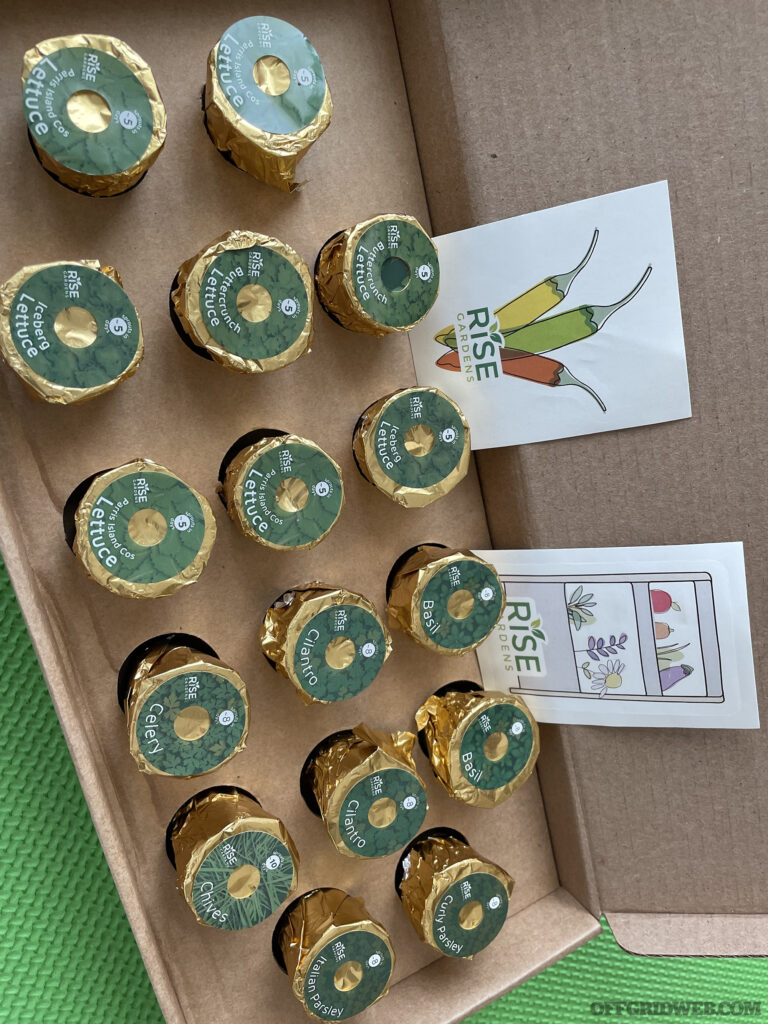
Above: All plants start life as seeds in seed pod cups made of coconut coir and peat moss. Rise offers dozens of seed varieties, depending on your needs and the size of your garden. To start, carefully poke a hole in the center of the seed pod, place in the nursery, provide an initial watering, and cover.
Keeping Your Garden Secure
Stockpile Supplies. Stockpile sufficient nutrients, seed pods, and other necessary supplies to keep growing food even if there is a supply chain interruption, or some other serious problem that prevents the free-flow of commerce. Keep your seed pods in a cool, dry environment. Rise seed pods have a one-year shelf-life. Make sure to stock up on seedless pods in case you decide to grow your own seeds.
- Have a Water Plan. Have a secondary source of water for use in your garden. If there is an event that affects your primary source of fresh water, makes sure you have a back-up plan and a reliable water supply for your garden. A three-level Family Garden will consume about four gallons of water per week. Plan ahead, store extra water, and have multiple ways of filtering water.
- Maintenance. The Rise Garden needs a good cleaning every four to six months. You can recycle the water from the Garden to your outdoor plants so nothing goes to waste. Periodic maintenance keeps all the components functioning well and supporting optimum plant growth.
- Backup Power Supply. To ensure you have uninterrupted growing cycles, have a back-up power supply to run the water pump and the LED lights in the event of a power outage. Consider a solar generator or an inverter generator.
- Avoid Prying Eyes. Position the Rise Garden in a location away from exterior windows, and out of sight by casual visitors to your home. Run the light cycle during the day so that you reduce the possibility that someone will see the grow lights and recognize that you have a hydroponic garden. Knowledge of your preparations, including your garden, should be on a need-to-know basis.
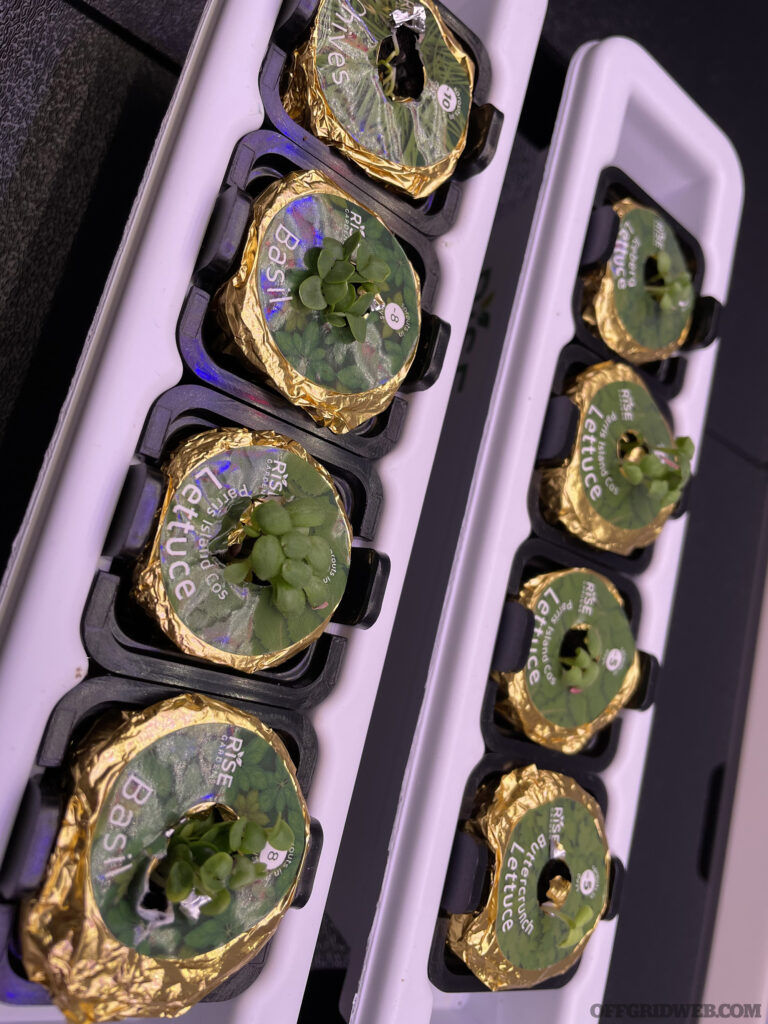
Above: Seedlings are protected, nourished, and kept at proper temperature within the nursery which provides the perfect growing environment. Once the seedlings develop their second set of leaves, they’re ready to be moved to one of the levels of the garden.
Supper’s On
There are many reasons to consider a hydroponic garden. You can grow impressive amounts of healthy and nutritious food in a controlled environment, use far less water and other consumable resources than traditional outdoor farming, and keep your valuable food far away from unpredictable weather, pests, weeds, diseases, and, of course, prying eyes.
Indoor hydroponic gardens have many benefits. From small table-top models with which you can grow a few herbs, to full-sized family units that will supplement your food stores, these gardens will consistently bring fresh produce to your table when you need it most.
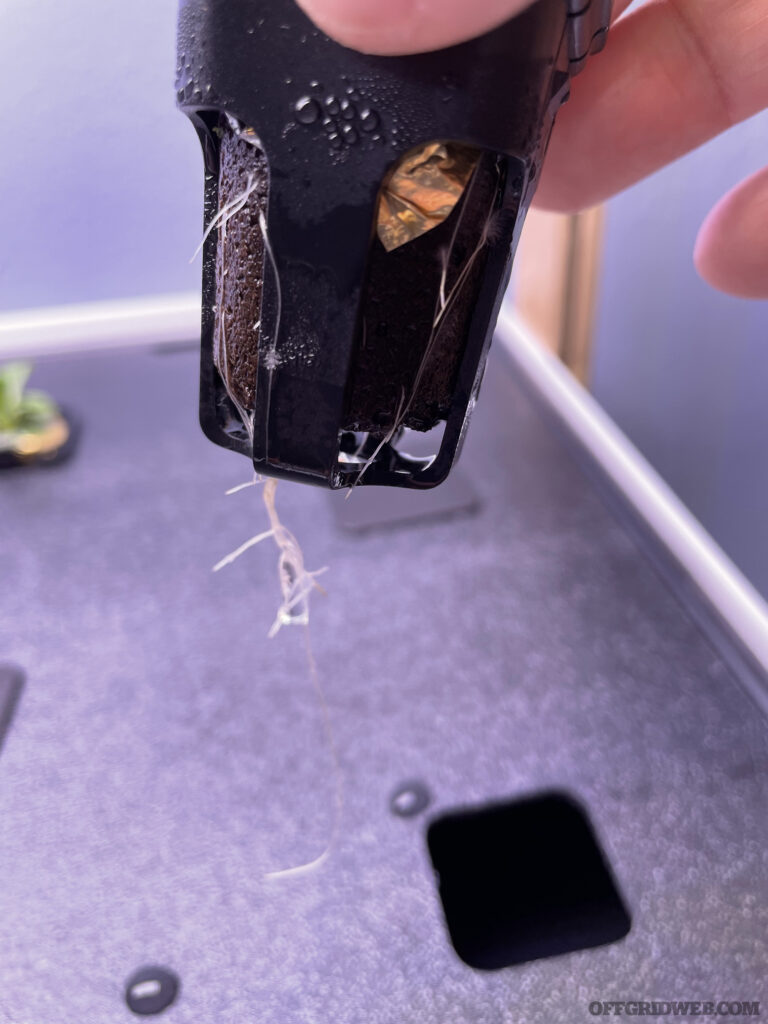
Above: Once the seedlings are moved to the garden, they quickly develop roots that extend into the water circulating throughout the system. Eventually these roots will mature and provide your growing plants with the necessary water and nutrients.
About the Author
Richard Duarte is a practicing attorney, an urban survival consultant, writer, firearms enthusiast, and freedom-loving American patriot. He’s the author of Surviving Doomsday: A Guide for Surviving an Urban Disaster, and The Quick Start Guide for Urban Preparedness. Duarte’s books are available at Amazon and other fine retailers. You can connect with Richard on Twitter @SurvivingDoomsd
Read More
Subscribe to Recoil Offgrid's free newsletter for more content like this.
Editor's Note: This article has been modified from its original printed version for the web.
The post Hydroponic Gardening: Indoor Survival Food appeared first on RECOIL OFFGRID.
By: Patrick Diedrich
Title: Hydroponic Gardening: Indoor Survival Food
Sourced From: www.offgridweb.com/preparation/hydroponic-gardening-indoor-survival-food/
Published Date: Sun, 03 Mar 2024 12:00:53 +0000
------------------------
Did you miss our previous article...
https://bushcrafttips.com/bushcraft-news/so-what-does-cb-stand-for-in-cb-radio
 What is BushcraftSurvival SkillsToolsVideosBushcraft CampsBushcraft KitsBushcraft ProjectsPrivacy PolicyTerms And Conditions
What is BushcraftSurvival SkillsToolsVideosBushcraft CampsBushcraft KitsBushcraft ProjectsPrivacy PolicyTerms And Conditions
